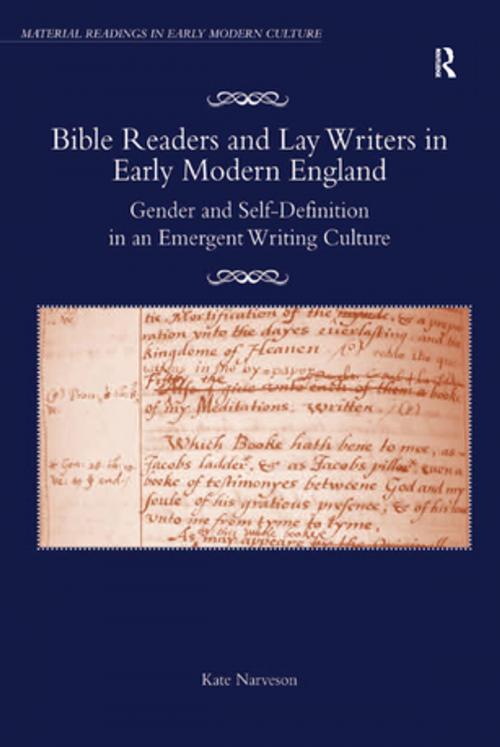Bible Readers and Lay Writers in Early Modern England
Gender and Self-Definition in an Emergent Writing Culture
Fiction & Literature, Literary Theory & Criticism| Author: | Kate Narveson | ISBN: | 9781317174424 |
| Publisher: | Taylor and Francis | Publication: | April 15, 2016 |
| Imprint: | Routledge | Language: | English |
| Author: | Kate Narveson |
| ISBN: | 9781317174424 |
| Publisher: | Taylor and Francis |
| Publication: | April 15, 2016 |
| Imprint: | Routledge |
| Language: | English |
Bible Readers and Lay Writers in Early Modern England studies how immersion in the Bible among layfolk gave rise to a non-professional writing culture, one of the first instances of ordinary people taking up the pen as part of their daily lives. Kate Narveson examines the development of the culture, looking at the close connection between reading and writing practices, the influence of gender, and the habit of applying Scripture to personal experience. She explores too the tensions that arose between lay and clergy as layfolk embraced not just the chance to read Scripture but the opportunity to create a written record of their ideas and experiences, acquiring a new control over their spiritual self-definition and a new mode of gaining status in domestic and communal circles. Based on a study of print and manuscript sources from 1580 to 1660, this book begins by analyzing how lay people were taught to read Scripture both through explicit clerical instruction in techniques such as note-taking and collation, and through indirect means such as exposure to sermons, and then how they adapted those techniques to create their own devotional writing. The first part of the book concludes with case studies of three ordinary lay people, Anne Venn, Nehemiah Wallington, and Richard Willis. The second half of the study turns to the question of how gender registers in this lay scripturalist writing, offering extended attention to the little-studied meditations of Grace, Lady Mildmay. Narveson concludes by arguing that by mid-century, despite clerical anxiety, writing was central to lay engagement with Scripture and had moved the center of religious experience beyond the church walls.
Bible Readers and Lay Writers in Early Modern England studies how immersion in the Bible among layfolk gave rise to a non-professional writing culture, one of the first instances of ordinary people taking up the pen as part of their daily lives. Kate Narveson examines the development of the culture, looking at the close connection between reading and writing practices, the influence of gender, and the habit of applying Scripture to personal experience. She explores too the tensions that arose between lay and clergy as layfolk embraced not just the chance to read Scripture but the opportunity to create a written record of their ideas and experiences, acquiring a new control over their spiritual self-definition and a new mode of gaining status in domestic and communal circles. Based on a study of print and manuscript sources from 1580 to 1660, this book begins by analyzing how lay people were taught to read Scripture both through explicit clerical instruction in techniques such as note-taking and collation, and through indirect means such as exposure to sermons, and then how they adapted those techniques to create their own devotional writing. The first part of the book concludes with case studies of three ordinary lay people, Anne Venn, Nehemiah Wallington, and Richard Willis. The second half of the study turns to the question of how gender registers in this lay scripturalist writing, offering extended attention to the little-studied meditations of Grace, Lady Mildmay. Narveson concludes by arguing that by mid-century, despite clerical anxiety, writing was central to lay engagement with Scripture and had moved the center of religious experience beyond the church walls.















